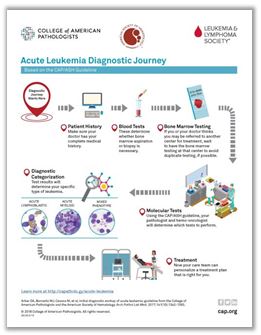An accurate diagnosis of the type of leukemia is important. The exact diagnosis helps the doctor to
- Estimate how the disease will progress
- Determine the appropriate treatment.
Diagnosing acute myeloid leukemia (AML) and your AML subtype usually involves a series of tests. Some of these tests may be repeated during and after therapy to measure the effects of treatment.
Tests Your Doctor May Use to Diagnose AML
Blood and Bone Marrow Tests
Blood and bone marrow tests are used to diagnose AML and the AML subtype. A change in the number and appearance of blood cells helps to make the diagnosis.
Blood Tests
Blood samples are generally taken from a vein in your arm. Your blood is sent to a lab for
- A complete blood count (CBC), which counts the number of red cells, white cells and platelets in the blood. Usually, patients with AML have lower-than-expected numbers of red blood cells and platelets.
- A peripheral blood smear, which shows the presence of leukemic blast cells (myeloblasts). A person with AML usually has too many immature white blod cells (leukemic blasts) in the blood and too few mature white blood cells. The immature cells do not function like normal, mature white blood cells.
Bone Marrow Tests
Samples of marrow cells are obtained by bone marrow aspiration and biopsy. Bone marrow testing involves two steps usually performed at the same time in a doctor's office or a hospital
- A bone marrow aspiration to remove a liquid marrow sample
- A bone marrow biopsy to remove a small amount of bone filled with marrow.
Bone marrow samples are usaully taken from the hip bone. Both samples are examined under a microscope to look for chromosomal and other cell changes.
Genetic Tests
Genetic tests help identify changes (mutations) in the genes or chromosomes of a cell. Identifying these specific changes can help determine the patient's treatment options and prognosis. The following tests may be done to examine the genes of a patient's leukemia cells
- Cytogenetic analysis (karyotyping)
- Fluorescence In Situ Hybridization (FISH)
- Molecular testing.
Diagnosing AML
Your doctor will work with a hematopathologist to confirm the diagnosis. A hematopathologist is a specialist who studies blood cell diseases by looking at samples of blood and marrow cells and other tissues.
The diagnosis of AML is confirmed by identifying:
- Leukemic blast cells in bone marrow samples
- The percentage of blast cells. Blasts are normally 1 to 5 percent of marrow cells. Having at least 20 percent blasts is generally required for a diagnosis of AML. But AML can also be diagnosed if the blasts have a chromosome change that occurs in a specific type of AML, even if the blast percentage is less than 20 percent.
- Characteristic markers (antigens) on the surface of blast cells, such as CD13 or CD33 (CD is an abbreviation for “cluster designation”).
- Cells based on the types of markers (antigens) on the cell surface, using a process called “immunophenotyping (flow cytomerty).”
Click here for the steps involved with a new diagnosis of acute leukemia.
Chromosome and Gene Abnormalities
Chromosomal changes and genetic mutations are an important prognostic factor for predicting remission rates, relapse risks and survival outcomes. However, not all patients have a chromosomal abnormality, and patients may have different gene mutations from other AML patients. Your doctor will perform a molecular analysis on your cells to identify specific genetic changes. See the LLS fact sheet, Cancer Molecular Profiling for more information.
Access the booklet Acute Myeloid Leukemia for a full listing of chromosome and gene abnormalities.
Newly Diagnosed Checklist
The College of American Pathologists (CAP) and the American Society of Hematology (ASH) provide practical guidance for patients and caregivers coping with a new diagnosis of acute leukemia. This checklist will help ensure that you receive the best treatment for your unique situation: Click Here
Related Links
- Download or order The Leukemia & Lymphoma Society's free booklet, Acute Myeloid Leukemia.
- Blood Tests
- Understanding Blood Counts
- Bone Marrow Tests
- Questions and Answers for Patients With Acute Leukemia


